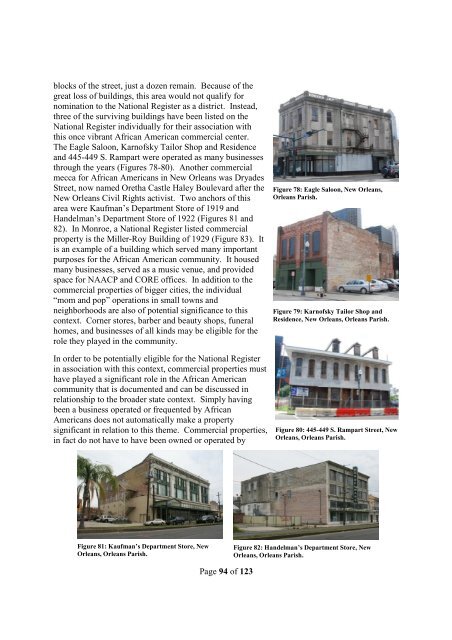The African American Experience in Louisiana
The_African_American_Experience_in_Louisiana
The_African_American_Experience_in_Louisiana
- No tags were found...
You also want an ePaper? Increase the reach of your titles
YUMPU automatically turns print PDFs into web optimized ePapers that Google loves.
locks of the street, just a dozen rema<strong>in</strong>. Because of the<br />
great loss of build<strong>in</strong>gs, this area would not qualify for<br />
nom<strong>in</strong>ation to the National Register as a district. Instead,<br />
three of the surviv<strong>in</strong>g build<strong>in</strong>gs<br />
have been listed on the<br />
National Register <strong>in</strong>dividually for their association with<br />
this once vibrant <strong>African</strong> <strong>American</strong> commercial center.<br />
<strong>The</strong> Eagle Saloon, Karnofsky Tailor Shop and Residence<br />
and 445-449449 S. Rampart were operated as many bus<strong>in</strong>esses<br />
through the years (Figures 78-80). Another commercial<br />
mecca for <strong>African</strong> <strong>American</strong>s <strong>in</strong> New Orleans was Dryades<br />
Street, now named Oretha Castle Haley Boulevard after the<br />
New Orleans Civil Rights activist. Two anchors of this<br />
area were Kaufman’s Department<br />
Store of 1919 and<br />
Handelman’s Department Store of 1922 (Figures 81 and<br />
82). In Monroe, a National Register listed commercial<br />
property is the Miller-Roy Build<strong>in</strong>g of 1929 (Figure 83). It<br />
is an example of a build<strong>in</strong>g which served many important<br />
purposes for the <strong>African</strong> <strong>American</strong> community. It housed<br />
many bus<strong>in</strong>esses, served as a music venue, and provided<br />
space for NAACP and CORE offices. In addition to the<br />
commercial properties of bigger cities, the <strong>in</strong>dividual<br />
“mom and pop” operations <strong>in</strong> small towns and<br />
neighborhoods are also of potential significance to this<br />
context. Corner stores, barber and beauty shops, funeral<br />
homes, and bus<strong>in</strong>esses of all k<strong>in</strong>ds may be eligible for the<br />
role they played <strong>in</strong> the community.<br />
In order to be potentially eligible for the National Register<br />
<strong>in</strong> association with this context, commercial properties must<br />
have played a significant role <strong>in</strong> the <strong>African</strong> <strong>American</strong><br />
community that is documented and can be discussed <strong>in</strong><br />
relationship to the broader state context. Simply hav<strong>in</strong>g<br />
been a bus<strong>in</strong>ess operated or frequented by <strong>African</strong><br />
<strong>American</strong>s does not automatically make a property<br />
significant <strong>in</strong> relation to this theme. Commercial properties,<br />
<strong>in</strong> fact do not have to have been owned or operated by<br />
Figure 78: Eagle Saloon, New Orleans,<br />
Orleans Parish.<br />
Figure 79: Karnofsky Tailor Shop and<br />
Residence, New Orleans, Orleans Parish.<br />
Figure 80: 445-449 S. Rampart Street, New<br />
Orleans, Orleans Parish.<br />
Figure 81: Kaufman’s Department Store, New<br />
Orleans, Orleans Parish.<br />
Figure 82: Handelman’s Department Store, New<br />
Orleans, Orleans Parish.<br />
Page 94 of 123


